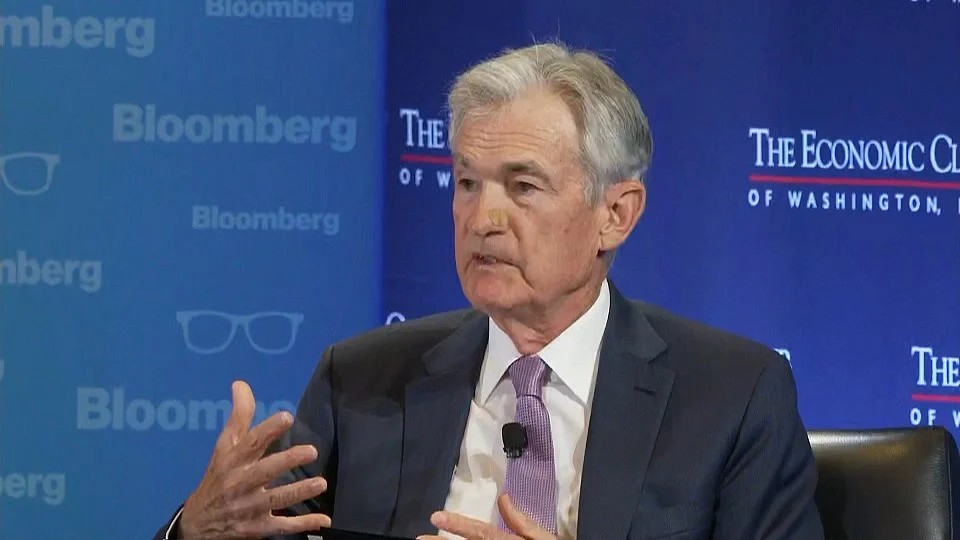Powell Says If You Wait Until Inflation Gets All The Way Down To 2%, You’ve Probably Waited Too Long
The Federal Open Market Committee next meets July 30-31, a gathering where the Fed is expected to hold interest rates steady.

(Bloomberg) -- Federal Reserve Chair Jerome Powell said second-quarter economic data has provided policymakers greater confidence that inflation is heading down to the central bank’s 2% goal, possibly paving the way for near-term interest-rate cuts.
Powell highlighted the three latest inflation readings, though he made clear he didn’t intend to send any specific message about the timing of rate reductions. He also cemented a shift in tone toward emphasizing potential risks to the labor market, alongside the Fed’s continued focus on taming prices.
“We didn’t gain any additional confidence in the first quarter but the three readings in the second quarter, including the one from last week, do add somewhat to confidence,” Powell said Monday during an interview with David Rubenstein at the Economic Club of Washington DC.

“Now that inflation has come down and the labor market has indeed cooled off, we’re going to be looking at both mandates,” Powell said. “They’re in much better balance.”
The Fed has held borrowing costs at the highest level in more than two decades for roughly a year, as the central bank seeks to lower inflation to its 2% target. Officials are aiming to further slow price growth without causing undue damage to the jobs market, which has so far held up well in the face of high borrowing costs.
More recently, however, the unemployment rate has risen gradually and is now at the highest level since 2021 amid other signs of softening in the broader labor market. Those trends, along with improving inflation data, have bolstered the case for the Fed to soon begin lowering its key policy rate.
Powell described the labor market as “no longer overheated” compared with earlier in the recovery from the Covid-19 pandemic, and said that “an unexpected weakening” could be a reason for the Fed to react.
Rate Outlook
The Federal Open Market Committee next meets July 30-31, a gathering where the Fed is expected to hold interest rates steady. Traders are betting on at least two cuts before the end of 2024, starting in September.
“My sense is that we’d really have to get adverse readings to knock them off the path of a 25-basis-point rate cut in September,” said Kathy Bostjancic, chief economist at Nationwide Mutual Insurance Co. “They want to really tame inflation, but there is an increasing recognition that there’s a risk that if they overdo it, they could risk a recession.”
The Fed has a dual mandate of fostering stable prices and promoting maximum employment, but a spike in price pressures in 2021 shifted policymakers’ focus to fighting inflation. That message has changed in recent weeks, with some officials — including Powell — emphasizing that concerns over inflation and rising unemployment were now more balanced.
“We want to get this right,” Powell said Monday. He echoed comments made last week during Congressional testimony, when Powell said inflation is not the only risk the economy faces.
Inflation has resumed downward progress toward the Fed’s target after stalling in early 2024. A measure of consumer inflation cooled broadly in June, with prices overall falling from the prior month for the first time since 2020.
Following the data’s release, San Francisco Fed President Mary Daly said some adjustment to interest rates will likely be warranted. Daly had previously warned the labor market was nearing an inflection point where a further slowing could cause unemployment to rise. Chicago Fed President Austan Goolsbee said last week that recent inflation data indicate inflation is on the path to 2%.
When asked about the potential market reaction to an assassination attempt against former President Donald Trump at a rally in Pennsylvania on Saturday, Powell condemned the violence and said he was grateful the injuries to Trump were not more serious. He declined to speak to the market impact.
Neutral Rate
Powell on Monday also weighed in on the so-called neutral interest rate, a concept that describes a Fed policy stance that neither promotes economic growth nor restricts it. He said it was likely the rate had moved up compared with the period between the 2008-2009 financial crisis and the pandemic.
“It seems to me that the neutral rate is probably higher than it was during the inter-crisis period, and so rates will be higher,” said Powell, noting that current policy feels “restrictive” but not “severely restrictive.“
He also reiterated the Fed’s commitment to avoiding political considerations when setting policy, after being asked about the central bank’s independence.
When questioned, Powell said he intends to complete his term as Fed chair, which ends in 2026, but declined to say whether he would continue to serve if reappointed.
--With assistance from Will Kubzansky and Catarina Saraiva.
(Updates throughout, beginning in second paragraph.)
More stories like this are available on bloomberg.com
©2024 Bloomberg L.P.